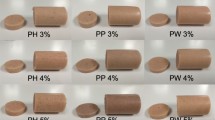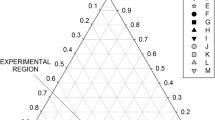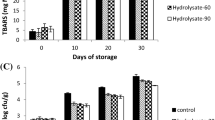Abstract
The objectives of this study were to determine the physicochemical properties and sensory characteristics of fish sausage made with 100 % threadfin bream (Nemipterus japonicus) surimi powder (SP100), a mix of 50 % surimi powder and 50 % frozen surimi (SP50), and a control (100 % frozen surimi). No significant differences in protein content and folding test results (P > 0.05) were detected among the SP100 and SP50 samples and the control. Gel strength of SP100 was lower (P > 0.05) than that of the control. The texture profile analysis (TPA) values (hardness, cohesiveness, springiness, and chewiness) of SP100 were significantly lower (P < 0.05) than those of the control. However, the TPA values of SP100 and SP50 were still within the textural range of Malaysian commercial fish sausages. The water holding capacity, and emulsion stability of SP100 were significantly lower (P < 0.05) than those of SP50 and the control. Of the cooking properties measured, SP100 had lower (P < 0.05) cooking yield, moisture retention, and fat retention than the control. Quantitative descriptive analysis (QDA) performed by 12 trained panelists showed that sensory characteristic (hardness, cohesiveness, springiness, and chewiness) scores of SP100 were lower than those of SP50 and the control. The use of surimi powder in fish sausage did not differ with that of control in the term of color, odor, or oiliness scored by panelists. The drying process impacted the texture properties of surimi when it was used in fish sausage. However, the use of surimi powder in fish sausage formulation is still accepted since the TPA values of SP100 and SP50 were still within the textural range of Malaysian commercial fish sausages.

Similar content being viewed by others
References
Almli V, Hersleth M (2012) Salt replacement and injection salting in smoked salmon evaluated from descriptive and hedonic sensory perspectives. Aquac Int, in press. doi: 10.1007/s10499-012-9615-4
Association of Official Analytical Chemists (AOAC) (2000) Methods of analysis, 17th edn. AOAC, Gaithersburg
Cardoso C, Mendes R, Nunes ML (2008) Development of a healthy low-fat fish sausage containing dietary fibre. Int J Food Sci Technol 43:276–283. doi:10.1111/j.1365-2621.2006.01430.x
Carjaval PA, Lanier TC, Macdonald GA (2005) Stabilization of protein in surimi. In: Park JW (ed) Surimi and surimi seafood, 2nd edn. CRC Press, Boca Raton, FL, pp 163–213
Chambers E IV, Bowers JA, Dayton AD (1981) Statistical designs and panel training/experience for sensory analysis. J Food Sci 46:1902–1906. doi:10.1111/j.1365-2621.1981.tb04515.x
Colmenero FJ, Barreto G, Mota N, Carballo J (1995) Influence of protein and fat content and cooking temperature on texture and sensory evaluation of bologna sausage. Lebensm-Wiss u-Technol 28:481–487. doi:10.1006/fstl.1995.0081
Dincer T, Cakli S (2010) Textural and sensory properties of fish sausage from rainbow trout. J Aquat Food Prod Technol 19:238–248. doi:10.1080/10498850.2010.509539
Gogoi BK, Oswalt AJ, Choudhury GS (1996) Reverse screw elements and feed composition effects during twin-screw extrusion of rice flour and fish muscle blends. J Food Sci 3:590–595. doi:10.1111/j.1365-2621.1996.tb13165.x
Hayes JE, Desmond EM, Troy DJ, Buckley DJ, Mehra R (2005) The effect of whey protein-enriched fractions on the physical and sensory properties of frankfurters. Meat Sci 71:238–243. doi:10.1016/j.meatsci.2005.03.005
Huda N, Abdullah A, Babji AS (2001a) Functional properties of surimi powder from three Malaysian marine fish. Int J Food Sci Technol 36:401–406. doi:10.1046/j.1365-2621.2001.00473.x
Huda N, Abdullah A, Babji AS (2001b) Substitution of tapioca flour with surimi powder in traditional crackers. Paper presented In: 16th Scientific Conference Nutrition Society of Malaysia, Kuala Lumpur, March 24–25, p 6
Huda N, Abdullah A, Mustapha WAW, Babji AS (2003) Penggunaan tepung surimi dalam formulasi bebola ikan. Sains Malaysiana 32:27–38, ISSN: 0126–6039
Huda N, Alistair TLJ, Lim HW, Nopianti R (2012) Some quality characteristics of Malaysian commercial fish sausage. Pak J Nutr 11(8):700–705. ISSN 1680–5194
Hughes E, Cofrades S, Troy DJ (1997) Effects of fat level, oat fibre and carrageenan on frankfurters formulated with 5, 12 and 30 % fat. Meat Sci 45:273–281. doi:10.1016/S0309-1740(96)00109-X
Lanier TC (1992) Measurement of surimi composition and functional properties. In: Lanier TC, Lee CM (eds) Surimi technology. Marcel Dekker Inc, New York, pp 123–163
Lin KW, Huang HY (2003) Konjac/gellan gum mixed gels improve the quality of reduced-fat frankfurters. Meat Sci 65:749–755. doi:10.1016/S0309-1740(02)00277-2
Matsumoto JJ, Noguchi SF (1992) Cryostabilization of protein in surimi. In: Lanier TC, Lee CM (eds) Surimi technology. Marcel Dekker Inc, New York, pp 357–388
Meilgaard M, Civille GV, Carr BT (1999) Sensory evaluation techniques, 3rd edn. CRC Press, Boca Raton, FL
Murphy EW, Criner PE, Grey BC (1975) Comparison of methods for calculating retentions of nutrients in cooked foods. J Agric Food Chem 23:1153–1157. doi:10.1021/jf60202a021
Niki H, Matsuda Y, Suzuki T (1992) Dried Forms of Surimi. In: Lanier TC, Lee CM (eds) Surimi technology. Marcel Dekker Inc, New York, pp 209–244
Nurkhoeriyati T, Huda N, Ahmad R (2011) Physicochemical properties and sensory analysis of duck meatballs containing duck meat surimi-like material during frozen storage. J Food Sci 71(1):91–98. doi:10.1111/j.1750-3841.2011.02519.x
Okada M (1992) History of surimi technology in Japan. In: Lanier TC, Lee CM (eds) Surimi technology. Marcel Dekker Inc, New York, pp 3–21
Park JW, Lin TM (2005) Surimi: manufacturing and evaluation. In: Park JW (ed) Surimi and surimi seafood. CRC Press, Boca Raton, FL, pp 33–98
Parvathy U, Sajan G (2011) Influence of cryoprotectant levels on storage stability of surimi from Nemipterus japonicus and quality of surimi-based products. J Food Sci Technol :1–6. doi: 10.1007/s13197-011-0590-y
Powers JJ (1984) Current practices and application of descriptive method. In: Piggott JR (ed) Sensory analysis of foods. Elsevier App Sci Pub, Barking, Essex, pp 179–242
Raju CV, Shamasundar BA, Udupa KS (2003) The use of nisin as a preservative in fish sausage stored at ambient (28 ± 2 °C) and refrigerated (6 ± 2 °C) temperatures. Int J Food Sci Technol 38:171–185. doi:10.1046/j.1365-2621.2003.00663.x
Reynolds J, Park JW, Choi YJ (2002) Physicochemical properties of Pacific whiting surimi as affected by various freezing and storage conditions. J Food Sci 67(6):2072–2078. doi:10.1111/j.1365-2621.2002.tb09503.x
Shaviklo GR, Olafsdottir A, Sveinsdottir K, Thorkelsson G, Rafifour F (2010a) Quality characteristics and consumer acceptance of high fish protein puffed corn fish snack. J Food Sci Technol 48:668–676. doi:10.1007/s13197-010-0191-1
Shaviklo GR, Thorkelsson G, Arason S, Kristinsson HG, Sveinsdottir K (2010b) The influence of additives and drying methods on quality attributes of fish protein powder made from saithe (Pollachius virens). J Sci Food Agric 90:2133–2143. doi:10.1002/jsfa.4062
Shaviklo GR, Thorkelsson G, Sveinsdottir K, Pourreza, F (2013) Studies on processing, consumer survey and storage stability of ready-to-reconstitute fish cutlet mix. J Food Sci Technol 50(3):900–908
Stone H, Sidel JL (1985) Sensory evaluation practices. Academic, Orlando, FL
Supavititpatana T, Apichartsrangkoon A (2007) Combination effects of ultra-high pressure and temperature on the physical and thermal properties of ostrich meat sausage (yor). Meat Sci 76:555–560. doi:10.1016/j.meatsci.2007.01.007
Toyoda K, Kimura I, Fujita T, Noguchi SF, Lee CM (1992) Surimi manufacturing process. In: Lanier TC, Lee CM (eds) Surimi technology. Marcel Dekker Inc, New York, pp 79–166
Acknowledgments
The authors acknowledge with gratitude the support given by Universiti Sains Malaysia for our research in this area and the aid of a research grant from the MALAYAN SUGAR MANUFACTURING COMPANY BERHAD.
Author information
Authors and Affiliations
Corresponding author
Rights and permissions
About this article
Cite this article
Santana, P., Huda, N. & Yang, T.A. Physicochemical properties and sensory characteristics of sausage formulated with surimi powder. J Food Sci Technol 52, 1507–1515 (2015). https://doi.org/10.1007/s13197-013-1145-1
Revised:
Accepted:
Published:
Issue Date:
DOI: https://doi.org/10.1007/s13197-013-1145-1




